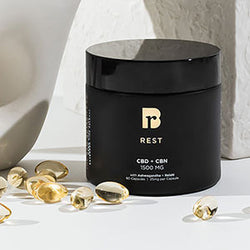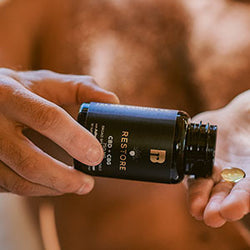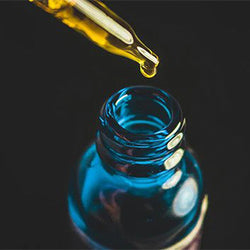
Have you ever squeezed a lemon wedge over a plate of shrimp capellini? Ever chopped up basil and inhaled the aromas that filled your kitchen? Ever ran your hand through lavender stalks in a raised garden and brought your fingers to your nose? You may have never heard of the chemical compounds known as “terpenes” before, but you can thank them for creating those smells—some of the most culture-defining olfactory sensations in the world.
Think of terpenes as aromatic molecules. Nearly all plants and flowers produce some terpene content, which help make the fragrances and flavors that may attract pollinators, repel predators like insects and herbivores, and even ward off infectious diseases. Terpenes are also found in some animals—usually in feathers, wool wax, fish liver oils, and pigments in butterfat—but they’re popularly associated with cannabis, perhaps because over 150 different terpenes have been identified in cannabis resin. (Or maybe because the names of cannabis aromas are so fun—anyone up for Sour Diesel or Pineapple Trainwreck?)
Since terpenes help boost a plant’s regeneration and oxygenation systems, some cannabis researchers believe that they can provide health benefits for humans, as well—although the studies on this subject have only recently ramped up, in large part due to the 2014 farm bill that kick-started hemp production in the US. At Raw Botanics, custom terpenes are one of the most vital building-blocks in our products because they provide a range of therapeutic effects for our users. Since so much misinformation can cloud up this industry, allow us to clear up the facts about terpenes and lay out a few reasons how they could benefit you.
Terpenes (and Terpenoids) Are Not Cannabinoids
Here’s another term in this discussion to familiarize yourself with—“cannabinoids,” or the chemical compounds found in cannabis. So far, scientists have pinpointed over 100 cannabinoids, each of which exhibits distinct effects when ingested. Note that cannabinoids and terpenes are different compounds. While terpenes won’t get you high, per se, scientists do consider them to be psychoactive, because researchers think that they impact or enhance the effects of THC—which, along with CBD, is probably the most famous of the cannabinoids.
One reason that you’ve probably noticed a certain alphabet soup swirling around the product descriptions in this industry—such as CBD, CBG, CBN, and CBC—is, in part, due to what cannabis experts term the “entourage effect.” Here’s the concept: A blend of terpenes and cannabinoids can produce more of the effects of cannabis than a single strain or compound. One study from 2010 found that a mixture of THC and CBD managed pain more effectively than THC alone. A review in “Frontiers in Neurology” concluded that people with epilepsy who were treated with a CBD-rich extract experienced improved symptoms and fewer side-effects than those who were treated with a purified CBD strain.
Other research has arrived at similar conclusions—that full-spectrum CBD products (which benefit from the synergies of multiple compounds working in tandem) can enhance certain treatments better than THC on its own. (You’ll be happy to learn that we designed all our CBD, CBC, CBN, and CBG products with the entourage effect in mind to produce maximum results for our customers.)
Now that you know the difference between terpenes and cannabinoids, here’s another distinction to bear in mind: Terpenes versus terpenoids. Terpenes are simple hydrocarbons. Terpenoids are complex compounds that contain additional functional groups. (In organic chemistry, “functional groups” refers to the group of atoms in a molecule with the singular properties that cause the molecule’s characteristic chemical reactions.) When growers dry and cure cannabis, the terpene atoms are oxidized and become terpenoids. (Although, we confess, the two terms are often used synonymously in the cannabis industry.)
There Are Many Types of Terpenes Found in CBD, CBG, CBC, CBN Products
While experts have identified 100+ terpenes in cannabis, researchers have found that only a handful of them produce any effect on users. Here are some of the most common terpenes—all of which we use in our inventory—as well as their bioactive properties:
Myrcene: Along with caryophyllene (which we’ll cover next), myrcene is one of the most prominent terpenes in cannabis. Most cultivars on the market contain some form of myrcene or caryophyllene. Myrcene is also found in a medley of fruits and herbs and plants—mangoes, thyme, lemongrass, and the flowers of the cannabis plant. With antibiotic, analgesic, antimutagenic, and anti-inflammatory properties, myrcene could produce sedating effects in patients. Studies have also determined that it may help treat osteoarthritis, alleviate pain, and prevent the breakdown of some cartilage cells.
Beta-caryophyllene: Hops, cloves, rosemary, pepper—these are a few of the herbs and veggies that contain beta-caryophyllene, which studies have shown can reduce nerve pain and inflammation. Like myrcene, beta-caryophyllene produces analgesic and anti-inflammatory effects, and it may help treat seizures and reduce cholesterol.
Beta-pinene: The most important snippet in this name for the layperson is “pine,” because peta-pinene is found in conifers like pine trees. Research indicates that beta-pinene may have antidepressant and anti-cancer properties, and it could prevent ulcers and boost airflow to the lungs. No wonder the Japanese turn to shinrin-yoku (roughly translated as “forest bathing”) for therapy, because, well, don’t you feel restored when you soak in the pine air of the mountain woods?
Humulene: A key component of hops, humulene is also found in cloves and ginger, and in ginseng—which has long been an ingredient in folk medicines. Analgesic, anti-inflammatory, and a potential asthma treatment, humulene may have a protective effect in some cells, which could guard against cancer. (Although the evidence on that point is still in its preliminary stages.)
Limonene: As the name indicates, limonene is most commonly found in the peels of citrus fruits, giving the rinds of lemons and oranges their fresh, acute smells. All the a-word properties that we’ve listed above—anti-inflammatory and antioxidant among them—can be ascribed to limonene, as well as antiviral, anticancer, and antidiabetic. Plus, it can be used to treat heartburn symptoms and (in studies of mice, at least) even has anti-anxiety properties.
… And There Are Many Types of Chemotypes
Myrcene and caryophyllene are the most predominant terpenes in cannabis cultivars on the market right now, but a single cultivar may express a range of “chemotypes” (or cannabis phenotypes)—a finding largely at odds with longstanding indica-sativa-hybrid classifications of cannabis. Recent studies of terpenes have concluded that categorizing cannabis according to its terpene and cannabinoid content is often a more effective way to identify the best medical uses for certain cultivars than relying on older tripart taxonomy models.
That shift in paradigms points to the growing importance of terpenes in the cannabis industry, especially since experimentation with terpenes prompted the development of a range of new products. Concentrates, for one, are potent masses of terpenes and cannabinoids that have been made into popular extracts like distillate or sauce. Isolates—extractions of a single terpene or cannabinoid—are enjoying widespread usage in natural medicine, and the potential for developing individual terpene extraction has led to a bevy of isolate products that aim to provide focused medicinal benefits.
You (Probably) Use Terpenes Every Day
Various terpene profiles provide some of the most recognizable, even beloved smells in the world. So it should come as no surprise that manufacturers isolate terpenes to produce the flavors and aromas of many products that you probably consume or use every day—including foods, perfumes, or household cleaners.
The terpene sabinene, for instance, shows up in nutmeg and cloves. Might it be argued, then, that the wintertime memories that a Christmas cocktail—topped off with a garnish of shaved nutmeg—evokes for you are possible only because of the presence of that particular terpene? We think it might. Think, too, how many other culinary experiences incorporate terpenes like linalool, a key component of lavender, or terpinolene, which can be found in sage, lilac, or rosemary. Mangoes, apples, broccoli, beer, black pepper—all contain terpenes.
D-limonene, the terpene sourced from citrus fruits, is used as a biodegradable cleaner. Turpentine oil—which appears in Vicks VapoRub, soap, cosmetics, and paint solvents—is primarily composed of pinene, limonene, and linalool. Many pesticides, dyes, and topicals also contain terpene content.
Be Wary of the Synthetic Stuff
Earlier we mentioned recent legislation on hemp that spurred a revitalization of the marijuana industry, but that itself spurs a question: What’s the difference between hemp and marijuana? The legal point of distinction between the two boils down to one word: “tetrahydrocannabinol,” or more commonly referred to as “THC.”
Hemp is cannabis with 0.3% or less THC content. Marijuana is cannabis that contains over 0.3% THC content (by dry weight). No matter how much THC it has, every cannabis strain contains some terpene content, but since it’s currently too pricey to harvest CBD from the flowers of hemp alone, many businesses use ethanol to extract CBD from the entire plant, including the stalks and leaves. Terpenes are lost through volatilization when the ethanol is removed, so CBD companies aim to reintroduce terpenes into their final products in ratios that occur organically in cannabis flowers—between 2–5%. Unfortunately, some manufacturers can develop formulations that contain up to 20% terpenes, which leads to the potential risks of “dabbing,” the act of inhaling cannabis concentrates through a dab rig or a vaporizer.
Synthetic terpenes are often present in oil-based vaping products at concentrations of 5–15%, and some studies have found that dabbing terpenes may produce benzene and methacrolein, toxicants that have been linked to certain cancers. Point being, if you’re into dabbing, please, dab at a low temperature.
Keeping It Raw
At Raw Botanics, we incorporate all the major cannabis terpenes into custom CBD products like CBN, CBC, and CBG softgels, tinctures, topical creams, and pillow and mask mists that provide a range of health benefits—assuaging pain, boosting your energy, or sleeping through the night. We source only natural ingredients from partners who use an advanced extraction process to produce cannabinoids of the highest quality. Browse our products and learn more about how they can help you find balance and replenish your sense of health and wellness.







